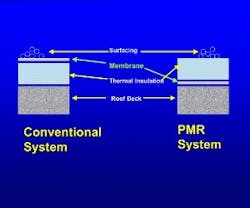Recent columns have addressed the need for higher R-factors mandated by our new energy codes. Where we would have used an inch of wood fiber, perlite or glass fiber insulation, with thermal resistances of roughly three per inch, the codes are now calling for R-factors of 25 or more depending upon the climate zone.
To get there with an R-value of 3 per inch of insulation, we would have to use 8.3 inches of material. With polyurethane insulation (which offers an R-value of 5.6), we could instead use 4.46 inches.
The building code generally speaks only to above-deck thermal insulation. In the last column, I mentioned cases where wood nailers can be completely eliminated from the equation by using formed metal edge boxes as an alternative to thick layers of treated wood.
This month, I’ll look at protected membrane roof systems (PMRs) in a new way, to see if they resolve some of today’s issues.
What Are PMRs?
If you are not familiar with PMRs, the May 2000 issue of Interface Magazine has a comprehensive article on these systems. The author, Michael Watts, points out:
Before roofs were insulated, the membrane was placed directly on the roof deck. The membrane was tempered from the extreme temperature because of heat loss through the deck in winter. It was also cooled somewhat in the summer because the underside of the deck would be much cooler than the top of the membrane.
This brings us perhaps to complete the circle: First, no thermal insulation on most low-slope commercial roof systems. The decks (T&G wood, concrete, etc.) were massive, so heat flow up or down was retarded. With the introduction of steel, plywood and oriented strand board, some insulation was needed, especially with steel roof decks to bridge the flutes of the deck. With the oil embargo of the early 1970s, combined with the viability of high thermal foam insulations such as urethane (renamed isoboards) and extruded polystyrene, it was not unusual to see specifications calling for perhaps two inches of urethane (resulting in twice the 5.6 R-factor).
Now, we are seeing specifications calling for perhaps R=25 or more! That certainly means our roofs will suffer from thermal shock because the membranes are again isolated from the benefits of the roof deck.
Why and How Does a PMR Resolve These Issues?
Richard (Dick) L. Fricklas, received a Lifetime Achievement Award and fellowship from RCI in 2014 in recognition of his contributions to educating three generations of roofing professionals. A researcher, author, journalist, and educator, Fricklas retired as technical director emeritus of the Roofing Industry Educational Institute in 1996. He is co-author of The Manual of Low Slope Roofing Systems (now in its fourth edition) and taught roofing seminars at the University of Wisconsin, in addition to helping develop RCI curricula. His honors include the Outstanding Educator Award from RCI, William C. Cullen Award and Walter C. Voss Award from ASTM, the J. A. Piper Award from NRCA, and the James Q. McCawley Award from the MRCA. Dick holds honorary memberships in both ASTM and RCI Inc.
One key word here is “protected.” The thermal issue is resolved because at least some, or all the thermal insulation is placed directly above the roof membrane. By this method, we enjoy not only the elimination of thermal shock, but protection against physical abuse and hail damage. In addition, current issues with air and vapor flow are also controlled, eliminating the need for a separate vapor barrier.
With the interest of rooftop solar panels, the PMR can be enhanced by surfacing extruded polystyrene (EPS) with a freeze-thaw resistant, latex-modified concrete. These products may be interlocked to provide wind resistance, or higher levels of wind resistance may be achieved at perimeters and corners by fastening stainless steel straps to supplement the interlocks.
From an environmental point of view, these cement-topped products (Lightguard® or Heavyguard®) can be reused during re-covering and the thermal performance of the recycled products may be warranted.
Another version of the PMR may incorporate pedestals which elevate the pavers off the membrane, facilitating drainage and moisture evaporation.
Additional information on PMRs for cold climates is available from NRCA.
Balance Test Data with Performance
How to evaluate membrane roofs.
Extend Service Life for a Sustainable Roof
The greenest roof is improving the one you already have.
Maximize Your Roof’s Life
Tools to raise the ceiling on your roof’s value.
About the Author
Richard L. Fricklas
Richard (Dick) L. Fricklas received a Lifetime Achievement Award and fellowship from RCI in 2014 in recognition of his contributions to educating three generations of roofing professionals. A researcher, author, journalist, and educator, Fricklas retired as technical director emeritus of the Roofing Industry Educational Institute in 1996. He is co-author of The Manual of Low Slope Roofing Systems (now in its fourth edition) and taught roofing seminars at the University of Wisconsin, in addition to helping develop RCI curricula. His honors include the Outstanding Educator Award from RCI, William C. Cullen Award and Walter C. Voss Award from ASTM, the J. A. Piper Award from NRCA, and the James Q. McCawley Award from the MRCA. Dick holds honorary memberships in both ASTM and RCI Inc.

